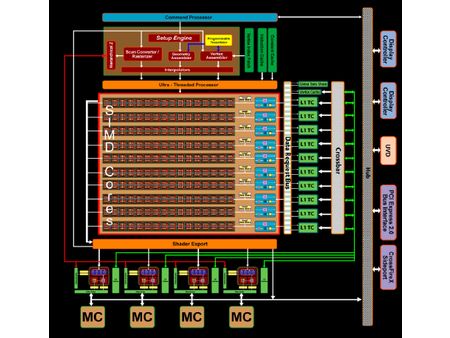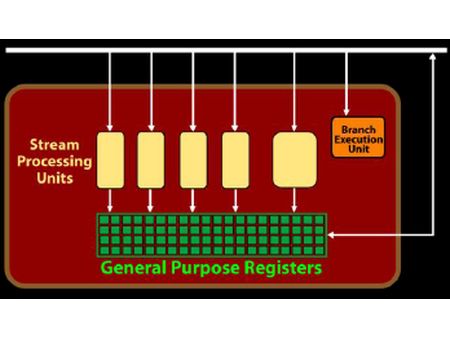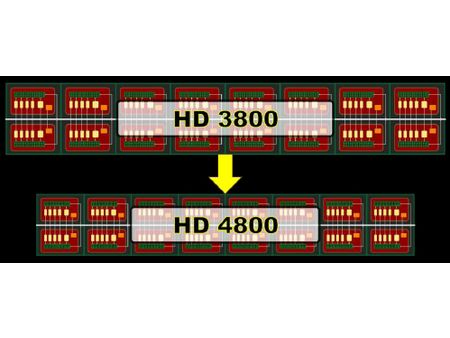ATI Radeon HD 4850: Smarter by Design?
The Architecture in Detail
Like Nvidia, AMD has chosen to build on its previous architecture rather than starting from scratch. It’s very much the same as that of the R600, which had already been re-used for the RV670.
SIMD cores
The architecture initially introduced with the Xenos, which is the same GPU used in the Xbox 360, is based on a group of SIMD arrays. The Xenos had three SIMD arrays, and the R600 and RV670 have four. The RV770 goes much further with ten.
As you’ve deduced, each SIMD array contains 80 ALUs since the GPU has 800 ALUs. That’s true, but it’s a slightly simplified view of reality. In practice, the 80 ALUs are not independent of each other. They’re grouped together in five-way VLIW units – 16 units per SIMD array.This organization implies certain restrictions on the instructions executed; each of the five instructions of a VLIW bundle has to be independent from the others. It’s up to the compiler to find enough independent instructions to saturate the ALUs – unlike the G80, which uses a more "hardware" solution.
Here’s an example to illustrate what we just described:
- I1 FADD R1, R1, 3.14
- I2 FMUL R2, R1, 1.41
- I3 FMAD R3, R0, 0.5, 0.5
In this case, Instructions 1 and 3 can share the same bundle, but not Instruction 2, which depends on the result of Instruction 1. If the compiler can’t find enough operations in its window of instructions, it has to fill the bundle with NOP instructions that don’t do anything, thus reducing the chip’s performance. What all that adds up to in the present case is that Nvidia ALUs will hit their peak performance more often because they’re less dependent on the underlying code; but the down side is that they’re much more costly in terms of transistors. AMD’s units depend strongly on the compiler’s performance (the compiler that’s “internal” to the driver, which reorganizes the assembler instructions generated by the HLSL), but AMD can afford to include a much larger number on a die that’s still significantly smaller.
The VLIW units themselves haven’t been heavily reworked; there are four units capable of executing a FMAD or an integer addition and a special unit capable of executing either a FMAD or an integer multiplication, or a transcendental function (sine, cosine, log, exp, etc.) The only real improvement is to bit-shifting operations in integers, which can now be handled by any of the five units, whereas on the 2900/3800 only the special unit could perform these operations. Rather than make them more powerful, AMD has concentrated on optimizing them in order to reduce their size on the die to be able to fit more of them on the device.
Get Tom's Hardware's best news and in-depth reviews, straight to your inbox.
Current page: The Architecture in Detail
Prev Page Raw-power and Fill Rate Tests, Continued Next Page Local and Global Data Share-
Neog2 Wow $200 in Best Buy for a HD 4850,Reply
$450 in Best Buy for a GTX 260.
And the 4850 is pretty close to the 280.
Ouu the 4870 is going to give Nvidia a run for there money
for the first time in a while. -
Prodromaki Oced Asus and 4850 instead of 4870 + too many games based on engines favoring nVidia...Reply
P.S. +1000 -> 2222 -
For Mass Effect the Engine limits the Maximum framerate to 62FPS. You can change this in the BIOENGINE.INI file (in the Documents\BioWare\Mass Effect\Config\ folder on Vista) by changing the value:Reply
MaxSmoothedFrameRate=62 in the Engine.GameEngine section -
puterpoweruser I can't believe it took nVidia coming out with a new card again to have tom's make a review finally of the 4850.Reply
"it was unavailable due to the sloppy handling of this launch"
Seriously? AMD can't control if their retail partners screwed the pooch on the release date, because they were so anxious to get people this great product. They made sure the product was readily available well before the launch date.
They should be praised for not having a paper launch, not told that it was a sloppy launch, very poor form saying that.
Hell i went to best buy and bought 2 4850's on sunday, when the cards weren't even supposed to be available yet, the guy told me "they have been in stock for over a month in the back, they aren't supposed to be available yet but i can get two for you." Were the AMD police supposed to come and smack best buy on it's hand and keep me from giving them profits?
Sorry if i'm ranting, just put the blame where it belongs. -
Malovane No offense, Fedy Abi-Chahla and Florian Charpentier, and thanks for the hard work, but I think the article should be revised a bit. First off, this should be a review of graphics cards.. not a burned out overclocked Asus motherboard. If you attribute your 4850 test crashing due to your motherboard.. why throw in results of 0 across the board for the 4850? You just corrupted your data and made the final fps averages meaningless, which is the thing people were generally interested in. Secondly, why in the world are you including tests that don't fit the definition of "playable" on any card in your test lineup (Crysis 2560x1600). It just throws off averages, as people aren't going to run this game at 7fps! If there's no card in the lineup that gets close to 30fps in a certain test, just move on! Save it for the quad crossfire or triple sli tests or something. You're giving high weights to resolutions that only a fraction of a percentage point of dedicated gamers can utilize (and those wouldn't bother with a single GPU). Lastly, please get those annoying gigantonormous screenies out of the review. It makes the review look like it was done by kindergarteners.Reply -
puterpoweruser I didn't finish reading the whole article yet but was the driver hotfix and the current 8.6 driver applied to the 4850?? It improved performance and stability greatly as i saw, it make the actual clock speed the card is set it run nicely and gives it great overhead to overclock through the CCCReply -
draxssab Who wants the Radeon 4800 full revew? (including the 4870, that do better than the GTX 280 in some games!)Reply
http://www.hardware.fr/articles/725-8/dossier-amd-radeon-hd-4870-4850.html
In french, but the graphs talk by themselves. Ho, and if you want a short translation = impressive and incredibly more efficient than Nvidia (if you compare the size of the GPU, yes it's A LOT more efficient) -
spaztic7 These reviews are getting better! Although I have seen many benchmarks and tests of the 4850 before this, I still love seeing how the 48x0 line is doing against the green machine! Anandtech.com has a kill 4870 review!Reply


